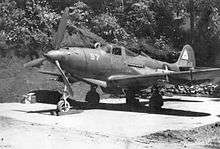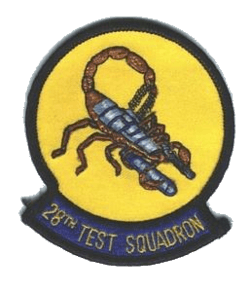28th Test and Evaluation Squadron
| 28th Test and Evaluation Squadron | |
|---|---|
|
Emblem of the 28th Test and Evaluation Squadron | |
| Active | 1940-present |
| Country | United States |
| Branch | United States Air Force |
| Role | Operational Testing |
| Motto(s) | OT Zealots Delivering Capabilities to the Warfighter |
| Mascot(s) | Scorpion |
| Engagements | World War II |
The 28th Test and Evaluation Squadron is an active United States Air Force unit. Its current assignment is with the 53d Wing, based at Eglin Air Force Base, Florida.
Overview
The 28th Test Squadron evaluates the effectiveness and suitability of weapons and avionics systems being procured or improved to support current and future USAF air combat capabilities. Squadron personnel direct test project planning and execution, as well as data gathering, analyzing, and reporting for tests involving conventional and nuclear air munitions, avionics subsystems, chemical warfare defense, aircrew life support, chemical defense systems, munitions and avionics support equipment, weapon release systems, and automated mission planning systems.
The IATF's primary objective is to improve the combat capability, reliability, and lethality of Air Force weapon systems through operationally realistic testing. Missions are performed through ground test, flight test, ground-based jammer testing, and various combinations of these techniques. The IATF's primary mission is to perform force development evaluations on the operational flight programs of the F-15 Eagle and F-16 Fighting Falcom fire control radar systems. This includes experimental changes to the OFPs as well as modifications to fielded OFPs. Additional responsibilities and capabilities include the following: Perform OFP OT&E and operational utility evaluations of F-15 and F-16 radars with the AIM-120 AMRAAM, identify radar system maintenance deficiencies and develop work-around solutions. Support advanced EA and EP system development and evaluation. Provide resident Air Force technical expertise on ACC radar and missile systems. Support other electronic warfare projects from Air Force, Department of Defense and various external customers with technical assistance or specialized hardware
- Detachment 1, 28th Test Squadron, located at Nellis AFB, Nevada
- The unit performs functional management for acquisition, modification, testing and certification for fighter, bomber and combat support aircrew training systems. The group also conducts foreign military exploitation and special access projects.
- Detachment 2, 28th Test Squadron, located at Tyndall AFB, Florida
- Plans, executes, and reports on Headquarters Air Combat Command-directed operational tests for multi-service integrated fighter avionics, weapons, and electronic warfare systems via operation of the $103 million Integrated Avionics Test Facility. Detachment personnel determine operational effectiveness and suitability for current and future weapons systems using Air Force and threat fighter radars, air-to-air missiles, electronic attack and electronic protection suites. Det 2, 28th TS also provides input and assistance to Headquarters U.S. Air Force, ACC, Air Force Operational Test and Evaluation Center, and Air Force Materiel Command in the development of test plans, conduct of test projects, collection of test data and production of final test and evaluation reports as directed by Headquarters ACC.
History

Established in 1939 as the 28th Pursuit Squadron and activated on 1 February 1940 at Albrook Field, Panama Canal Zone. The squadron was formed from a collection of four officers and enlisted ranks drawn from Headquarters and Headquarters Squadron, 16th Pursuit Group, the 24th Pursuit Squadron, the 44th Reconnaissance Squadron, the 29th Pursuit Squadron, the 74th Bombardment Squadron and the 15th Base Headquarters and Air Base Squadron. Initially equipped with Boeing P-26A Peashooters, the mission of the squadron was air defense of the Panama Canal. This remained the squadron's mission throughout its existence in Sixth Air Force.
After the Pearl Harbor Attack, was dispersed to Paitilla Point Field, Panama, 08°58′37″N 079°30′31″W / 8.97694°N 79.50861°W and re-equipped with some Curtiss P-40 Warhawks. By March 1942, was moved to La Joya #2 Aerodrome 09°04′59″N 079°19′00″W / 9.08306°N 79.31667°W in Panama where it remained until 2 May 1942, only to return to Paitilla Point again in June. Was re-designated as the 28th Fighter Squadron on 15 May as part of a USAAF-wide renaming program. The unit then remained there until November, when it moved again to Chame Field, Panama. In November 1943, the Squadron was assigned directly subordinate to the XXVI Fighter Command, and by December, the unit had been re-equipped with Bell P-39Q Airacobras.
By February 1944, the Squadron was maintaining a detachment at Pocri Field, Panama. In May 1945, conversion to P-38 Lightnings began, however, no sooner had conversion to the P-38's been completed than the unit was moved to Howard Field, where the entire complement of P-38s was hangared and the unit activities ran down with the end of the war in Europe. The squadron ceased all flying activities in June, and the P-38s were reassigned to other units in the command while personnel were returned to the United States for demobilization.
By October 1945, the squadron was reduced to a non-operational administrative organization. Inactivated on 15 October 1946.
During the Cold War, the squadron was reactivated by Tactical Air Command as the 28th Fighter-Bomber Squadron at Clovis AFB, New Mexico on 8 April 1953 and was programmed to receive F-86F Sabres. However, it was neither manned or equipped due to personnel and equipment shortages and was inactivated on 25 June.
Re-activated as an Air Material Command test squadron at Eglin AFB, Florida in 1998.
Heraldry
A brown scorpion with light blue armor plate fastened to back by rivets, holding in the right claw and legs a large, medium blue aerial bomb, and in the left claw and legs a light blue and black aerial machine gun with black and white cartridge belt affixed thereto, draped over stinger on tail (Approved 19 May 1945).
Lineage
- Constituted 28th Pursuit Squadron (Interceptor) on 22 December 1939
- Activated on 1 February 1940.
- Redesignated 28th Fighter Squadron on 15 May 1942
- Inactivated on 15 October 1946
- Redesignated 28th Fighter-Bomber Squadron on 3 March 1953
- Activated on 8 April 1953
- Inactivated on 25 June 1953
- Redesignated and activated as 28th Test and Evaluation Squadron, 1 October 1988
- Redesignated 28th Test Squadron, 1 October 1995
- Redesignated 28th Test and Evaluation Squadron, 1 October 2002
Assignments
- 37th Pursuit (later Fighter) Group, i February 1940
- XXVI Fighter Command, 1 November 1943
- 6th Fighter Wing, 25 August-15 October 1946
- 37th Fighter-Bomber Group, 8 April-25 June 1953
- Air Armament Center, 1 October 1988
- 53d Wing, 1 October 1995
- 53d Test Management Group, 1 October 2002 – Present
Stations
- Albrook Field, Canal Zone, 1 February 1940
- Rio Hato AAB, Panama, 5 October 1940
- Albrook Field, Canal Zone, 13 November 1940
- Patina Point Afld, Panama, 9 December 1941
- Detachment at La Chorrera Afld, Panama, 26 March-2 May 1942
- Chame Afld, Panama, 10 November 1942
- Detachment at Pocri Afld, Panama, 22 February-2 August 1944
- Howard Field, Canal Zone, 25 September 1945 – 15 October 1946
- Clovis AFB, New Mexico, 8 April-25 June 1953
- Eglin AFB, Florida, 1 October 1988 – Present
Aircraft
- P-26 Peashooter, 1940–1941
- P-40 Warhawk, 1941–1942
- P-39 Airacobra, 1942–1945
- P-38 Lightning, 1945
References
![]() This article incorporates public domain material from the Air Force Historical Research Agency website http://www.afhra.af.mil/.
This article incorporates public domain material from the Air Force Historical Research Agency website http://www.afhra.af.mil/.
- Maurer, Maurer (1983). Air Force Combat Units Of World War II. Maxwell AFB, Alabama: Office of Air Force History. ISBN 0-89201-092-4.
- Hagdedorn, Dan (1995), Alae Supra Canalem: Wings Over the Canal, Turner Publishing, ISBN 1563111535

.jpg)